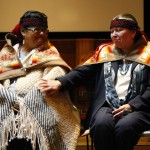Gale Courey Toensing and Indian Country Today Media Network Staff
This article was originally published on Presidents’ Day 2012.
Unlike the statement in Indian Country Today Media Network’s “Best Presidents for Indian country” story, it’s a bit easier identifying the “worst” presidents for Indian country. Five tend to stand out with the majority of the rest huddled together after that. Here are our nods to the presidents who did more harm than good for Native Americans while in office.
Andrew Jackson: A man nicknamed “Indian killer” and “Sharp Knife” surely deserves the top spot on a list of worst U.S. Presidents. Andrew Jackson “was a forceful proponent of Indian removal,” according to PBS. Others have a less genteel way of describing the seventh president of the United States.
“Andrew Jackson was a wealthy slave owner and infamous Indian killer, gaining the nickname ‘Sharp Knife’ from the Cherokee,” writes Amargi on the website Unsettling America: Decolonization in Theory & Practice. “He was also the founder of the Democratic Party, demonstrating that genocide against indigenous people is a nonpartisan issue. His first effort at Indian fighting was waging a war against the Creeks. President Jefferson had appointed him to appropriate Creek and Cherokee lands. In his brutal military campaigns against Indians, Andrew Jackson recommended that troops systematically kill Indian women and children after massacres in order to complete the extermination. The Creeks lost 23 million acres of land in southern Georgia and central Alabama, paving the way for cotton plantation slavery. His frontier warfare and subsequent ‘negotiations’ opened up much of the southeast U.S. to settler colonialism.”
Jackson was not only a genocidal maniac against the Indigenous Peoples of the southwest, he was also racist against African peoples and a scofflaw who “violated nearly every standard of justice,” according to historian Bertram Wyatt-Brown. As a major general in 1818, Jackson invaded Spanish Florida chasing fugitive slaves who had escaped with the intent of returning them to their “owners,” and sparked the First Seminole War. During the conflict, Jackson captured two British men, Alexander George Arbuthnot and Robert C. Ambrister, who were living among the Seminoles. The Seminoles had resisted Jackson’s invasion of their land. One of the men had written about his support for the Seminoles’ land and treaty rights in letters found on a boat. Jackson used the “evidence” to accuse the men of “inciting” the Seminoles to “savage warfare” against the U.S. He convened a “special court martial” tribunal then had the men executed. “His actions were a study in flagrant disobedience, gross inequality and premeditated ruthlessness… he swept through Florida, crushed the Indians, executed Arbuthnot and Ambrister, and violated nearly every standard of justice,” Wyatt-Brown wrote.
In 1830, a year after he became president, Jackson signed a law that he had proposed – the Indian Removal Act – which legalized ethnic cleansing. Within seven years 46,000 indigenous people were removed from their homelands east of the Mississippi. Their removal gave 25 million acres of land “to white settlement and to slavery,” according to PBS. The area was home to the Cherokee, Creek, Choctaw, Chickasaw and Seminole nations. In the Trail of Tears alone, 4,000 Cherokee people died of cold, hunger, and disease on their way to the western lands.
Dwight Eisenhower: President Dwight Eisenhower, the World War II hero who served as President from 1953 until 1961, was an early advocate of consultation. On August 15, 1953, he signed into law H.R. 1063, which came to be known as Public Act 280, because he believed it would help forward “complete political equality to all Indians in our nation.”
Public Act 280 transferred extensive criminal and civil jurisdiction in Indian country from the federal government to California, Minnesota, Nebraska, Oregon, Wisconsin, and Alaska. Other states were allowed to opt in later. In a signing statement accompanying the bill, Eisenhower objected to certain sections because they allowed other states to impose H.R. 1063 on tribal nations, “removing the Indians from federal jurisdiction, and, in some instances, effective self-government” without requiring “full consultation.” He recommended that Congress quickly pass an amendment requiring states to consult with the tribes and get federal approval before assuming jurisdiction on reservations.
The bad news is Eisenhower didn’t veto H.R. 1063. If he had, the devastating termination and relocation era would have been delayed and possibly stopped, according to Edward Charles Valandra in his book Not Without Our Consent: Lakota resistance to termination, 1950-59. “Indeed, his veto could have stopped its passage. Arguably, had Eisenhower vetoed H.R. 1063, the termination program would have been effectively curtailed long enough for Native peoples to mobilize a preemptive campaign against further measures similar to H.R. 1063. At the very least, Native, state, and U.S. relations would have taken a much different course from what the Native population actually experienced,” Valandra wrote.
Although the termination era had its roots in the post World War II years and lasted through the 60s, it came under full steam during Eisenhower’s presidency. During that time, Congress “terminated” – withdrew federal acknowledgment from and the trust relationship with – 109 tribes and removed more than 1,365,000 acres of land from trust status. More than 13,260 people lost their tribal affiliation.
A writer on the Native American Netroots website sees the termination era as part of America’s Cold War battle against global communism, “Following World War II, the United States turned its energies into fighting communism. Indian reservations and policies which would allow Indians to determine their own futures were deemed communistic and the federal government set out once again to destroy (terminate) Indian tribes and to ‘allow’ Indians to assimilate like other immigrants. Indian people and their tribal governments vigorously opposed these policies,” the writer says. President Richard Nixon ended the termination era in 1970 and introduced the “self-determination” era.
George W. Bush: While George W. Bush was one of three presidents since 1995 to issue proclamations designating November as National American Indian Heritage Month, his understanding of tribal sovereignty is limited.
At the Unity: Journalists of Color Conference in 2004 when questioned by Mark Trahant, the then editorial page editor of the Seattle Post-Intelligencer, about sovereignty in the 21st century, Bush gave a muddled answer.
“Tribal sovereignty means that. It’s sovereign. You’re… You’re a… you’ve been given sovereignty and you’re viewed as a sovereign entity,” Bush stumbles through his answer. “And therefore the relationship between the federal government and tribes is one between sovereign entities.”
And sovereignty isn’t the only Native American issue Bush was unclear on during his presidency. A 2004 report titled “The Civil Rights Record of the George W. Bush Administration, 2001-2004” by the U.S. Commission of Civil Rights details where the president fell short on civil rights for Native Americans.
“President Bush has acknowledged the great debt America owes to Native Americans. However, his words have not been matched with action,” the report states.
To back up its claims, the report details how Bush did not provide sufficient funding for tribal colleges and universities, and even proposed cutting copy.5 billion in funding for education programs that benefit Native Americans.
The report also detailed how the Bush administration provided inadequate funding for the Indian Health Service, funding it at $3.6 billion in 2004 when health needs in Indian country called for copy9.4 billion.
Housing in Indian country wasn’t funded adequately by Bush either. He failed to provide enough funds to cover the cost of the 210,000 housing units that were needed.
The final point made by the commission was Bush’s termination of critical law enforcement programs, like the Tribal Drug Court Program.
Abraham Lincoln: The majority of the United States knows Lincoln as the president who “cannot tell a lie,” and as the leader of the Emancipation Proclamation. However, if you were to ask Native Americans their perception of the great president, the image would be much darker. Lincoln made no effort to work with Native Americans, instead he worked against them. When the Sioux demanded its copy.4 million they had been promised for the sale of 24 million acres of land, that had already started to be settled by whites, Lincoln did nothing. According to an article on the United Native America website, The Sioux revolted and Lincoln called upon General John Pope to handle the uprising. Pope began his campaign by saying, “It is my purpose to utterly exterminate the Sioux. They are to be treated as maniacs or wild beasts, and by no means as people with whom treaties or compromise can be made.”
Lincoln did not argue, the Indians were defeated, and Lincoln ultimately signed the fates of 38 Indian prisoners in Mankato, Minnesota according to Greatdreams.com/lies.htm. In Lincoln’s defense, 303 Indian men were sentenced to death, but Lincoln only signed for 38. On December 26, 1862 the largest mass execution in United States history took place, based on a cloud of doubt.
The Navajos were subjected to a similar situation as the Dakota, as were others. Lincoln followed his “American System” through battles in the Plains, South and Southwest crippling tribes and forcing them from their lands.
Before he was president, Lincoln was the attorney for the railroads, which in order to be completed, the Indian “situation” had to be taken care of—a belief Lincoln carried into office with him. His railroad connections according to United Native America would lead, not only to the attempted annihilation of the Indian, but to tremendous scandals in the administration of another of Lincoln’s war criminals, Ulysses S. Grant.
Author David A. Nichols when describing how Lincoln handled the conflicts with the Indians in The Other Civil War: Lincoln and the Indians addressed it by saying, “in his response to these crises, Lincoln was instrumental in determining the fate of Native Americans in the years following his death.”
Ulysses S. Grant: Grant made it on our ‘Best’ Presidents list as well. Mostly because his intentions were in the right place and something that hadn’t been seen in that time. But those good intentions can’t save him from the fact of the matter. Ultimately it was one word that sealed Grant’s fate for this list—reservations. His hopes to move Indians closer to white civilization by creating these “Native communities” backfired. They became a form of bad policy that did more harm than good by cutting ties for Native Americans to a vast area of land they had been used to occupying for hundreds of years. Reservations isolated Native Americans to an area that was and is taken advantage of by federal government administrations for years to come.





















